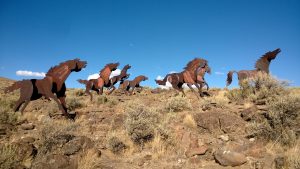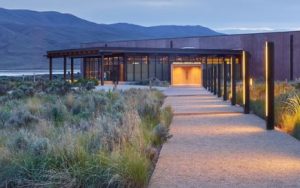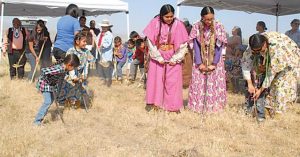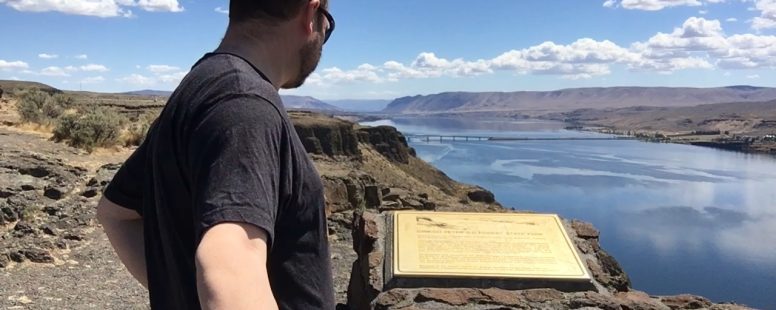Columbia Gorge Overlook and the Wanapum Indian Tribe
Until recent times, the Wanapum Indians inhabited the banks of the Columbia River in Washington State from Beverly Gap to Pasco, about 75 miles south. The Wanapums were a very religious and peaceful people, living on venison, berries, roots, and fish…expertly caught using nets, spears and woven willow traps. Yet today, the Wanapums are virtually extinct. What happened to the tribe that once numbered in the thousands, and what’s left of their culture?
How many times have we all driven through Vantage, Washington, with our eyes fixed on Spokane or Seattle, or the Tri-Cities, never bothering to stop and marvel at the grandeur of the Columbia Gorge? But just on the east side of the bridge lies two hidden gems worth a quick stop if you’re breezing through on a beautiful day.
 Heading east on I-90, you’ll find the Wild Horse Monument standing guard over the gorge. But westbound travelers are treated to a different attraction…a scenic overlook that both educates and amazes. Take a short stroll on the ADA accessible pathways and you’ll find yourself marveling at the region’s geology as much as you’ll be checking out the world-class views.
Heading east on I-90, you’ll find the Wild Horse Monument standing guard over the gorge. But westbound travelers are treated to a different attraction…a scenic overlook that both educates and amazes. Take a short stroll on the ADA accessible pathways and you’ll find yourself marveling at the region’s geology as much as you’ll be checking out the world-class views.
If you pull over and take a few minutes at the scenic overlook just north of Vantage, you’re going to see some amazing sights, especially on a beautiful day. You’re also going to be able to read some interpretive panels that they have set up.
In addition to the paved trails, visitors are also welcome to explore the landscape on their own…following a network of dirt trails through the scrub brush and desert flowers, at every turn being greeted with a panoramic view of Vantage.
You’ll also find the helpful interpretive panels describing the geology of the area and the heritage of the site on which you’re standing. For example, across the river from the overlook lies Ginkgo Petrified Forest State Park. Petrified wood was discovered there as early as 1898, though it wasn’t until 1927 when crews built a highway from Vantage to Ellensburg that they realized just how much of it they had.
This scenic site is also a great place to get out, stretch the legs and learn a bit more about the great state of Washington, the Columbia River, and the people who first populated its banks. One of the things I learned was that the area used to be populated with the Wanapum Indian tribe. Unfortunately, according to the panel, because the Wanapums never fought against the whites, they were never given any treaties, there were never given any reservations or land, and therefore, were not considered a recognized tribe. And today, the population of Wanapum Indians has all but disappeared.
Or has it?
That’s the story, according to the panels at the scenic overlook. But they were most likely installed prior to the proliferation of the internet, and endless information delivered in an instant. By the time I got home from shooting video at the overlook, I learned that the Wanapum Tribal heritage is very much alive and well.

The Wanapum Heritage Center is instrumental in perpetuating the importance of the culture, traditions and beliefs of the Wanapum. (Photo courtesy Wanapum Heritage Center)
In fact, the Wanapums have a beautiful heritage center in Priest Rapids. As spiritual people, the Wanapum continue to practice their religion. Friendly, understanding, and respectful of all people and things, the Wanapum only wish to live in peace. Through strenuous and prudent efforts, the Wanapum have successfully built relationships with federal, state, and local agencies.
For more than 60 years, the Wanapum and Grant PUD have worked together to protect, preserve and perpetuate the natural and cultural resources of the area. Located next to the Wanapum’s ancestral village and Priest Rapids Dam, this 50,000 square-foot building is instrumental in perpetuating the importance of the culture, traditions and beliefs of the Wanapum for years to come.

Members of the Wanapum Band of Native American peoples break ground for the new Heritage Center. (Photo courtesy Sun Tribune)
The Wanapums have been preserving their way of life, language and traditional physical culture for the next generation. Visitors to the heritage center can learn how to preserve, use, and make tools, gaining knowledge so that the culture can be passed on to the younger generation. The Wanapum Heritage Center’s Living Culture Program includes traditional tool-making (such as flint knapping for arrowheads and projectile points), food-gathering (including when, where, what, and how to gather traditional foods), and weaving and beadwork.
Washington is filled with opportunities for learning more about history, heritage, and culture, so make sure you make time for a quick stopover wherever you’re headed next!


